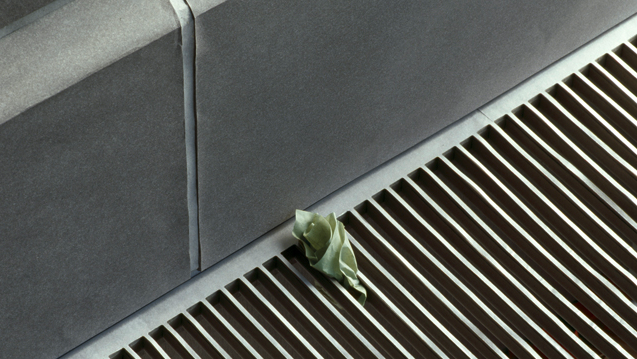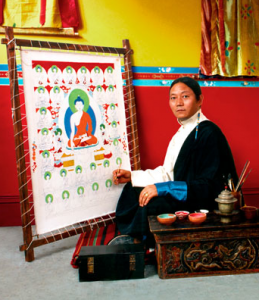There have been 24 previous Kaldor Public Art Projects in Sydney, but never anything so cool and oblique as Thomas Demand’s The Dailies 2012. The work is not installed in a gallery, but in the Commercial Travellers’ Association Club, in the MLC Centre, just off Martin Place.
The unconventional venue is an essential part of a project that is really a series of fictions. Or is it a single, multi-faceted fiction?
Demand (b.1964) is a German multimedia artist who photographs details of everyday life, then reconstructs these objects out of paper. He proceeds to photograph the paper sculptures, producing images that look superficially normal while retaining tell-tale traces of artificiality. It is often hard to specify what is wrong with these pictures – it is as though our senses bristle when we detect an alien aura.
After Demand has taken his photo the sculpture is destroyed, making each image a unique record of a vanished facsimile of reality – if you can imagine such a spiralling descent into the void. It seems to be a working demonstration of Karl Marx’s famous quote from the Communist Manifesto about the progress of modernity: “All that is solid melts into air.” It is also reminiscent of Jean Baudrillard’s claims that nowadays the simulacre can seem more real than the real itself.
Demand’s work fits so neatly into these paradigms that one can see why he has become such a rising star on the contemporary art circuit. Another reason may be his outlandish perfectionism. In order to get the quality of print that he required, the artist travelled to an island off the coast of Seattle where he had tracked down two printers still using a dye-transfer process. This, in itself, is a remarkable reflection of the speed with which technologies are discarded today, as soon as a new, more efficient method comes along.
Some viewers may feel that Demand’s images are so unassuming it was hardly worth his while to seek out the world’s last dye-transfer printers. But the modesty of his objects – an ashtray, a pin board, a stool, two saucers, pegs on a clothes-line – is a necessary part of the illusion. Think of these works as descendants of those Dutch still lifes in which a glass or a piece of fruit has the power to hold us spellbound.
Fifteen photos are displayed on the walls of fifteen cell-like bedrooms in the CTA Club. Each room also contains a fragment of a short story by American writer, Louis Begley, perhaps best known for his novel, About Schmidt, which was made into a film starring Jack Nicholson. The story for The Dailies 2012 concerns a German commercial traveller named Gregor, who checks into the CTA Club, and soon finds himself entwined with Leni, the Czech receptionist.
Despite a little Kafkaesque allusion, this slender tale will never be a highlight in Begley’s collected works. The power of The Dailies 2010 comes from the cumulative effect of reading the story fragments, looking at each photo, and breathing in a subtle scent by Miuccia Prada, commissioned for this project by the artist.
Each bedroom in the CTA Club is arranged in a circle around a central axis. Wandering with feelings of mild vertigo from one room to the next, it seems as though one is beginning to inhabit this story, playing the role of Gregor. It’s a strangely unsettling sensation. This is partly a function of the images and words, but one should not underestimate the contribution of the architecture, designed by Harry Seidler in association with the great Finnish modernist, Pier Luigi Nervi.
The CTA rises up like a concrete mushroom at the base of the MLC Centre. The tiny, Spartan bedrooms may seem guaranteed to induce spasms of loneliness and depression. But it is only when one descends to the bar on level 2 that the real weirdness sets in. Nothing appears to have changed since the 1970s – the decade that fashion forgot. The décor is a blaze of bright red, offset with bays of poker machines. On the walls are reproductions of paintings by old masters such as Pieter Breugel the Elder, J.M.W.Turner, Van Gogh, Pro Hart and Elioth Gruner. It looks like the set of a David Lynch movie. For people like me, who never suspected that such amazing time capsules lie buried beneath the CBD, this was more of a revelation than Demand’s fastidious installation.
It’s only fair to treat the bedrooms and the bar of the CTA Club as a Total Work of Art – a time-tunnel collaboration between Thomas Demand and his colleagues; Harry Seidler; and an inspired interior decorator of the early seventies.
Up in Brisbane last week to see Modern Woman, a show of drawings from the Musée d’Orsay, held at the Queensland Art Gallery, I also caught two thirds of a survey by the Tibetan artist, Gonkar Gyatso (b.1961). This was such a unique event that I’m going to let the Orsay drawings wait for another week and take a closer look at two exhibitions that conjure up a minefield of ideology, faith and scepticism.
Gonkar Gyatso: Three Realms was shown in Brisbane’s three major public venues after the QAG: The University of Queensland Art Museum, the Griffith University Art Museum, and the Institute of Modern Art. This was the first time these institutions had ever managed to work together – an historic event in its own right. The realisation of the project is a tribute to curator, Simon Wright, of GUAG, who had the initial idea and put in the sleepless nights.
The IMA component was held between August and October last year. Griffith has one impressive installation that takes up the entire gallery, while the UQ museum contains the largest and most varied body of work.
The ‘three realms’ that Gyatso has negotiated are his youthful days as a committed Communist, studying in Beijing; the period when he returned to Tibet, rediscovered his roots, and became an artist-in-exile, across the border in Dharamsala; and his move to London, where he studied at St. Martins and Chelsea, emerging as a truly international figure, albeit still an exile.
These ‘realms’ are recorded in his mildly self-parodying photo-work, My Identity (2003), which shows the artist in four different states of personal evolution. It is worth noting that each new phase of self-discovery entailed the gradual assimilation of a new language. Scarcely less dramatic were the psychic upheavals Gyatso experienced in jettisoning Maoist ideology, and opening himself up to the cultural traditions of Tibetan Buddhism. Today, despite his worldwide success and growing renown, he remains a permanently displaced person.
Like all Tibetan artists, the image of the Buddha and the traditions of thangka painting are intrinsic to Gyatso’s work. Yet no other artist has produced so many radical, irreverent variations on the Buddha silhouette, often plastered with tiny stickers or cartoon images drawn from the chaos of pop culture. Within an icon of perfect tranquility one finds a raging, noisy inferno of comic book heroes, material goods, and snippets of current affairs. It is nothing less than new manifestation of Pop Art, arriving in the West as Maoism once did, like ‘a wind from the East’.
The obvious interpretation is that Gyatso is criticising the rampant materialism, the lust for objects and sensations that takes the place of spiritual experience for so much of the world today. On the other hand, he might be putting those ancient traditions on notice – warning that Buddhism, like every other activity, has to move with the times.
It’s more likely the former than the latter, but this lingering ambiguity is an important part of Gyatso’s work. His installation at Griffith features broken, beheaded effigies of the seated Buddha, strewn across the floor in pools of very fine sand. It’s possible to imagine the sand as ash, and the work as an oblique reference to the Tibetan protestors who recently immolated themselves in Lhasa. It would be impossible to imagine that Gyatso is indifferent to these horrific events, but the work may also be seen as nothing more than a comment on the loss of spiritual and cultural traditions.
Whether this entails an active vandalism or a slow erosion, the issue is universal, not confined to Tibet. The ambiguity is a necessary part of Gyatso’s methods, as all Tibetan artists – and perhaps all Chinese artists – are treated with a degree of suspicion by those Chinese authorities who are current adopting a softly-softly approach. As Savita Apte writes in the catalogue, Gyatso is not a natural rebel, but a believer in following the path of “the middle way”. This is shrewd choice, as extremes in art not only inflame the establishment, they tend to polarise viewers and end in hypocrisy. The middle way is that rare and happy place where both an artist and his audience may stop and think.
Thomas Demand: The Dailies 2012, Commercial Travellers Association Club, March 23 – April 22, 2012
Gonkar Gyatso: Griffith University Art Gallery, Brisbane, February 24 – April 21, 2012
Queensland University Gallery, Brisbane, February 29 – April 29, 2012
Published in the Sydney Morning Herald, April 14, 2012





